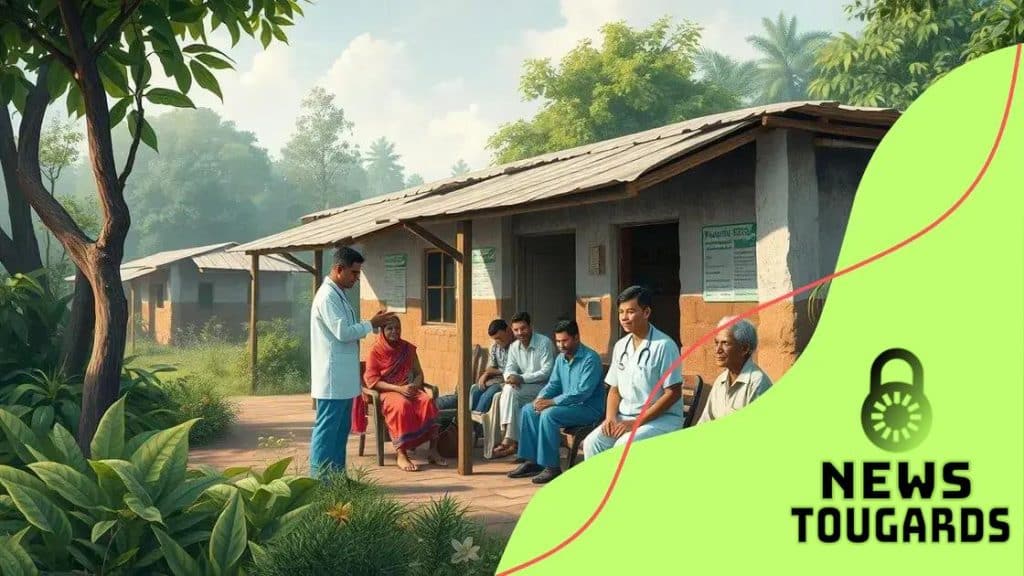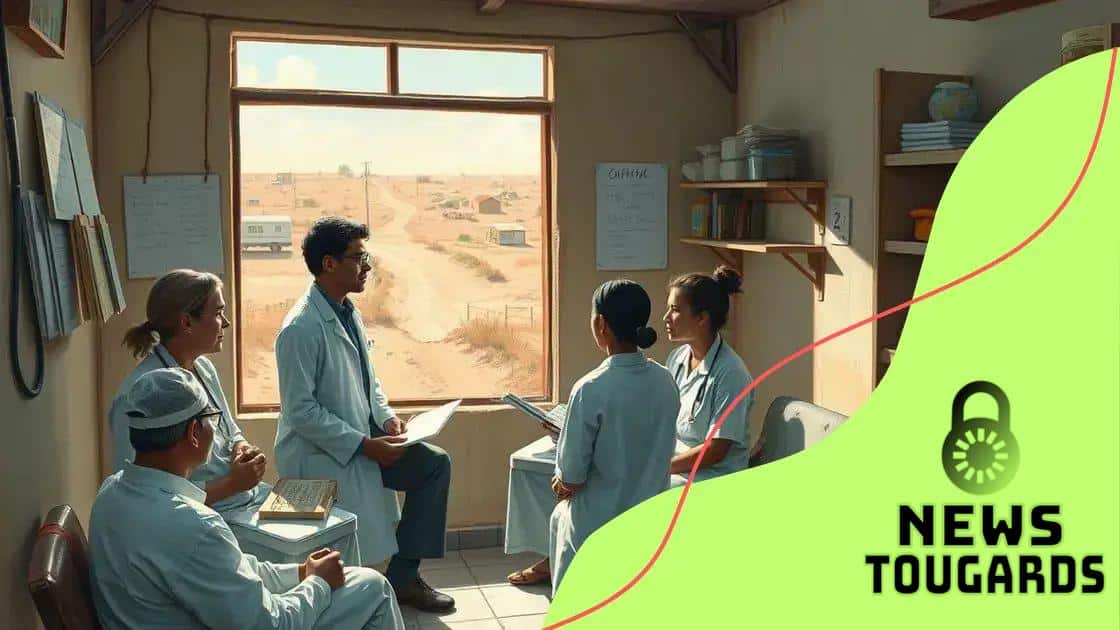The impact of federal healthcare initiatives on rural communities

The impact of federal healthcare initiatives on rural communities includes improved access to care, increased utilization of telehealth services, and enhanced local healthcare workforce development, addressing unique challenges faced by these populations.
The impact of federal healthcare initiatives on rural communities is significant, shaping the way healthcare is delivered and received. Have you ever wondered how these programs change lives and access to services? Let’s dive in!
Overview of federal healthcare initiatives
The Overview of federal healthcare initiatives reveals essential programs aimed at improving health access and quality across various communities. These initiatives have transformed the landscape of healthcare, particularly in underserved areas.
In recent years, the federal government has introduced multiple initiatives that cater specifically to the needs of rural populations. These programs aim to enhance healthcare accessibility and provide support to those who need it most.
Key Federal Programs
Several federal programs focus on healthcare improvements in rural areas. Among them, the most notable include:
- Medicare and Medicaid: These programs provide critical health coverage for low-income families and the elderly.
- Rural Health Care Services Outreach Program: This initiative helps communities develop innovative ways to improve access to care.
- Federally Qualified Health Centers (FQHCs): FQHCs offer comprehensive and affordable healthcare services regardless of a person’s ability to pay.
- Telehealth Services: Expanding telehealth options has made it possible for rural residents to receive care remotely, breaking down geographical barriers.
These programs play a pivotal role in bridging the healthcare gap experienced by people in rural communities. With enhanced funding and supportive policies, they aim to elevate healthcare standards and promote preventive care.
Additionally, initiatives like the Health Resources and Services Administration (HRSA) ensure that healthcare providers in rural areas get the necessary training and resources. Effective implementation leads to improved patient outcomes, emphasizing the direct benefits of these initiatives.
While there are notable successes, challenges still exist. Many rural communities face a lack of healthcare professionals, transport issues, and limited access to advanced medical technologies. Addressing these challenges requires ongoing support and innovation.
In summary, understanding the overview of federal healthcare initiatives illustrates a commitment to enhancing healthcare access in rural areas. By recognizing these efforts, we can appreciate their significant impact on improving lives across the nation.
How initiatives improve access to care
The initiatives designed to improve access to care have brought significant changes to rural communities. These programs focus on removing barriers and ensuring that everyone can receive necessary medical attention.
One way these initiatives work is through increased funding for healthcare facilities. This funding allows clinics to hire more staff, improve services, and offer extended hours to accommodate patient schedules.
Benefits of Improved Access
When access to care is improved, many positive outcomes follow. Some of the key benefits include:
- Better Health Outcomes: Patients who can see their doctors more regularly tend to have better health results. Preventative care helps detect issues early.
- Increased Patient Satisfaction: When people can access services nearby, they report higher satisfaction with their healthcare experiences.
- Community Health Improvement: Healthy individuals contribute to stronger communities, benefiting everyone.
- Economic Benefits: Improved healthcare access can lead to a more productive workforce, positively impacting the local economy.
Additionally, the use of telehealth services has transformed how care is delivered. Patients can consult with healthcare professionals remotely, saving time and resources. This service significantly aids those in isolated areas where clinics may be far away.
Moreover, initiatives that provide transportation services to medical appointments help individuals who lack reliable transport. These services are crucial for ensuring that people do not miss vital healthcare appointments.
In many cases, federal programs partner with local organizations to spread awareness about new services. This outreach ensures that residents know their options and how to access care effectively.
Overall, the focus on improving access to care not only supports individual health but fosters a stronger, healthier community. These initiatives highlight a commitment to the well-being of all citizens, underscoring the importance of accessible healthcare for everyone.
Challenges faced by rural healthcare providers

Rural healthcare providers face many challenges that can affect the quality and accessibility of care. Understanding these obstacles is essential for addressing the healthcare needs of less populated areas.
One significant challenge is the shortage of healthcare professionals. Many rural areas struggle to attract and retain doctors, nurses, and specialists. This shortage can lead to longer wait times for patients and reduced availability of services.
Key Challenges
Some other notable challenges that rural healthcare providers encounter include:
- Lack of Resources: Many small healthcare facilities do not have access to advanced medical equipment and technologies.
- Funding Issues: Rural clinics often operate on tight budgets, which can limit their ability to provide comprehensive care.
- Transportation Barriers: Patients may have difficulty reaching healthcare facilities due to long distances and lack of public transport options.
- Economic Factors: The local economy can impact healthcare funding, influencing the ability to offer competitive salaries for healthcare workers.
Additionally, the remoteness of many rural locations can hinder communication and collaboration among healthcare providers. This situation may lead to fragmented care, where patients receive inconsistent treatment across different providers.
Technology can play a role in alleviating some challenges. For example, telemedicine has become a valuable tool. It allows rural patients to consult with specialists remotely, reducing the need for travel and providing quicker access to necessary care.
Rural healthcare providers also face unique challenges in educating the community. Many residents may not be aware of the available healthcare services or may lack understanding about health issues. Effective outreach and education are essential for improving health literacy and ensuring patients seek the care they need.
Ultimately, addressing these challenges requires support from federal and state governments, as well as community engagement and innovative solutions tailored to meet the specific needs of rural populations.
Success stories from rural communities
Success stories from rural communities highlight the positive impact of federal healthcare initiatives. These stories showcase how targeted efforts can transform healthcare access and improve lives.
One remarkable example is the establishment of a community health center that serves a small town. This center provides essential medical services that were previously unavailable, ensuring that residents no longer have to travel long distances for basic healthcare.
Examples of Success
Some specific success stories include:
- Increased Preventive Care: A rural community adopted a health outreach program that significantly increased the number of residents receiving annual check-ups, leading to early detection of health issues.
- Telehealth Implementation: A local clinic implemented telehealth services, allowing patients to consult with specialists without needing to leave their homes. This service greatly improved access for the elderly and those with mobility challenges.
- Community Engagement: Residents collaborated to launch a mental health support group, providing valuable resources to those facing challenges. This initiative reduced stigma and encouraged people to seek help.
- Improved Maternal Health: A rural area partnered with healthcare providers to offer prenatal and postnatal care programs, resulting in healthier pregnancies and better outcomes for mothers and babies.
These stories illustrate the tangible benefits of federal healthcare initiatives in rural areas. They show that with the right support, communities can overcome challenges and create a healthier environment for their residents.
Moreover, sharing these success stories inspires other rural areas to take similar steps, demonstrating that meaningful change is possible. The role of community involvement is crucial, as local efforts often lead to the most impactful results in improving health outcomes.
Overall, the achievements of these rural communities serve as a beacon of hope, emphasizing that federal support combined with local determination can lead to significant improvements in healthcare access and quality.
Future outlook for healthcare in rural areas
The future outlook for healthcare in rural areas is both promising and challenging. As federal healthcare initiatives evolve, rural communities are expected to see significant improvements in access and quality of care.
One major focus will be on expanding telehealth services. As technology advances, more patients in remote areas will gain access to healthcare professionals through virtual consultations. This shift can drastically reduce wait times and provide essential medical advice without the need for travel.
Innovative Solutions
Additionally, innovative solutions will emerge to address current challenges. Some potential developments include:
- Increased Financial Support: Continued investment in rural healthcare facilities will help improve services and upgrade medical equipment.
- Workforce Development: Programs aimed at training and retaining healthcare professionals in rural areas are crucial. Scholarships and incentives can attract new talent.
- Community Partnerships: Collaborations between local governments, health organizations, and schools will promote health education and outreach.
- Technology Integration: Incorporating advanced technology, such as AI and data analytics, will enhance the quality of care and streamline operations.
Furthermore, community-driven initiatives will likely play a larger role in shaping the future of rural healthcare. When local residents become actively involved in their healthcare systems, they can better advocate for their needs and develop tailored solutions.
As healthcare policies continue to adapt, stakeholders must remain committed to understanding the unique needs of rural communities. By prioritizing health equity, the goal is to ensure everyone, regardless of location, receives high-quality healthcare.
With these transformative changes on the horizon, the future of healthcare in rural areas can lead to healthier, more resilient communities.
The future for healthcare in rural areas looks bright. As we continue to see progress from federal initiatives, communities can expect improved access and quality of care. Innovations like telehealth and community partnerships are helping to break down barriers. Local involvement is essential, as residents play a key role in shaping their healthcare environment. With ongoing support and commitment, rural healthcare can thrive, leading to healthier and more resilient communities.
FAQ – Frequently Asked Questions about Healthcare in Rural Communities
What are federal healthcare initiatives?
Federal healthcare initiatives are programs designed to improve access and quality of care in underserved areas, particularly rural communities.
How does telehealth benefit rural healthcare?
Telehealth allows patients in rural areas to access healthcare professionals remotely, reducing travel time and making care more accessible.
What challenges do rural healthcare providers face?
Rural healthcare providers often face challenges such as staff shortages, limited resources, and transportation barriers that affect patient access.
How can communities improve their healthcare systems?
Communities can improve their healthcare systems by engaging with local health programs, advocating for resources, and participating in public health initiatives.





